Washington, DC (CNN Business)Food delivery companies are under increased scrutiny over how some worker tips contribute to their base pay. Now some are backtracking on their controversial policies.
DoorDash is the latest service to revisit its tipping policies following a New York Times report that put the issue once again in the spotlight. A reporter spent time as a delivery person and showed how customer tips contribute to worker pay, a policy in place since 2017.
In response to the article's backlash, DoorDash CEO Tony Xu tweeted that the policy would change going forward and Dashers' earnings would increase by the exact amount a customer tips.
"We thought we were doing the right thing by making Dashers whole when a customer left no tip. What we missed was that some customers who did tip would feel like their tip did not matter," he tweeted.
The debate over the role tips play in a person's income isn't new but has been amplified by the gig economy, which is under increasing criticism for its treatment of workers, and how well they are paid. Food delivery companies also face pressure to keep costs low as they seek to go public or become profitable. For businesses desperate to improve their finances, tips are an enticing pot of money.
In recent years companies like DoorDash, Amazon and Grubhub have encouraged customers to leave gratuities, but they often don't reach workers in the traditional sense, according to tipping experts.
In some cases a big tip will contribute to a payment that's already guaranteed to workers. The exact specifics vary by company. A worker may be guaranteed $15 for a delivery, or an hour's work. If their base pay and the customer tip only reach $12, the company will kick in the extra $3. But if the customer left a large tip, pushing the total payment over the $15 threshold, the company wouldn't have to kick in extra money.
The practice is legal, but breaks from the tradition of a tip being money a worker wouldn't otherwise receive.
Tipping experts say consumers are unlikely to be aware that in some cases a generous tip will save the companies money.
Michael Lynn, a professor at Cornell School of Hotel Administration who researchers tipping, told CNN Business these practices are morally wrong.
"This is a defrauding of the consumer," Lynn said. "It's a voluntary payment from the consumer. So it's important that they not be cheated or duped into giving money to a company they wouldn't otherwise do it. I would be willing to tip the delivery person, I'm not willing to tip DoorDash."
Instacart, which competes with DoorDash, Amazon Prime Now and Grubhub (GRUB), abandoned a similar practice in February following criticism. Other food delivery platforms such as Uber Eats, Postmates and Caviar do not contribute to worker payments with tips.
The practice of subsidizing worker payments with tips impacts millions of employees outside the gig economy, according to Eli Wilson, a University of New Mexico sociology professor who has studied tipping.
Restaurant servers generally rely on tips. Most state and federal law allows employers to pay a lower minimum wage if employees regularly receive tips.
Wilson said the gig economy has amplified the trend of employers substituting tips in lieu of wages, as these companies seek to shift risk to workers and offload expenses on customers.
"This as a very slippery slope," Wilson said. "In this context, it opens another can of worms to allow employers to use them as a wage replacement when worker earnings are already not particularly high."
When asked about their tipping policies, Grubhub says 100% of tips go to drivers, in addition to their pay. Amazon said workers receive 100% of tips. However, their base pay varies, but they'll always get at least $18 an hour.
But the practice is confusing as, even though all tips go to a driver, that doesn't mean they'll see a change in their wages. Also, the payment structures sometimes change, perplexing workers.
Sean, a gig economy worker who asked that his full name not be used because of fear of retaliation by Amazon, noticed in the spring of 2017 that his earnings dropped by about $175 a week. He contacted Amazon to inquire about what seemed like a change in his tips. (He didn't know for sure, because Amazon's payment statements don't reveal how much tips contribute to earnings.) He was told that Amazon recently introduced "base variable earnings," the portion of total earnings paid directly by Amazon.
In the letter, Amazon only partially described how "base variable earnings" are calculated. Factors include the length of shifts, and how much demand there is for deliveries, which are determined before the work is completed. Amazon also adds "supplemental earnings," to meet its promise that drivers will make $18-25 per hour. The letter doesn't reveal how Amazon calculates supplemental earnings, and whether total earnings end up at $18 an hour, $19 an hour or more.
Consumers are left in the dark too as Amazon and Grubhub in some markets guarantee certain payments to workers. So when customers are more generous with tips, the companies have to pay less to meet minimums.
"It's certainly not coming to me in a way I think a customer would think it's coming to me," said Morgan Aycock, a gig economy work who sometimes drives for Grubhub in Charleston, South Carolina, regarding tips. "So sure, that's a little bit shady, until it becomes the norm ŌĆö if it becomes the norm."
If a driver completes a lot of orders, they should meet the hourly minimum, which is a $12 guaranteed payment in some markets, and Grubhub's payment to them will not be impacted by how large the tip is.
When a customer places an order on Grubhub, they aren't told if there are hourly minimums in their market and if their driver has met or is likely to meet them without the aid of a tip. This makes it impossible to know if tipping will subsidize Grubhub's own payment to the driver, or is an added payment to the driver.
Grubhub said in a statement that it pays drivers on a per-order basis, and will on occasion give a "true-up bonus" if drivers don't have enough orders, so that they remain loyal to Grubhub.
Grubhub discloses on pay statements what tips were received, and what it is paying. Amazon doesn't break out tips, leaving drivers in the dark about how much they are being tipped and how much of the $18 an hour they're guaranteed is coming from Amazon.
An Amazon spokeswoman declined to say why the company does this. Amazon also has not revealed how the pay, aside from tips, is determined. Amazon says that on average it contributes over $19 an hour to a delivery partner's pay, and that delivery partners earn $18-25 an hour.
The company has not publicly acknowledged its practice of subsidizing guaranteed payments with tips. But individuals identifying themselves as Amazon drivers have reported the practice on social media. A Los Angeles Times investigation earlier this year revealed that Amazon uses tips to cover guaranteed pay. An Amazon spokeswoman declined to comment on the report.










